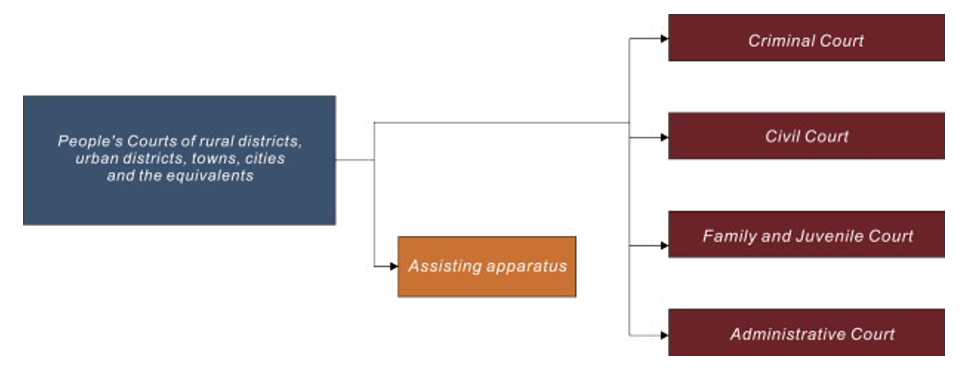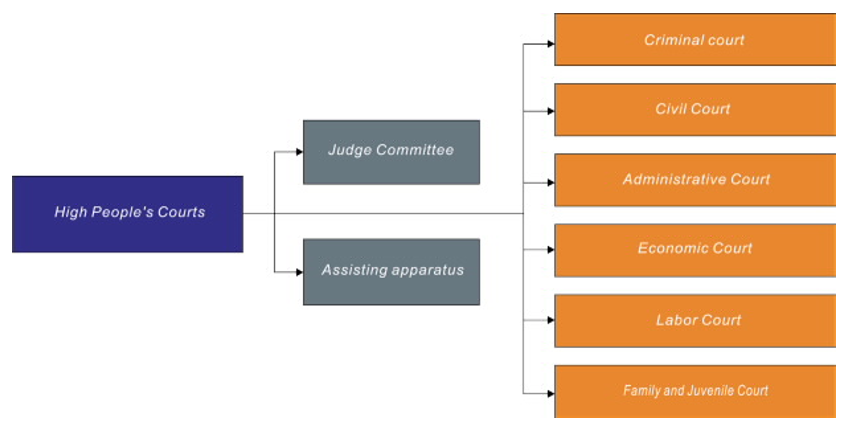Vietnamese People’s Court System and How it Works in Vietnam
The People’s Courts are judicial organs exercising judicial power on behalf of the State. They are are responsible for safeguarding justice, human rights, citizenship rights, the socialist regime, interests of the State, legitimate rights and interests of organizations and individuals. The Vietnamese People’s Court system is comprised of the following five types of courts:
1. The Supreme People’s Court;
2. The People’s High Courts (3 High Courts for the North, Centre and South of Vietnam);
3. Provincial People’s Courts (63 Provincial Courts);
4. District People’s Courts (710 District Courts);
5. Military Courts (3 types).
6. Understanding the Vietnamese People’s Court system in depth will help you determine the appropriate steps to take when bringing a case to a court for hearing in Vietnam.
I. PEOPLE’S COURTS OF RURAL DISTRICTS, URBAN DISTRICTS, TOWNS, CITIES AND THE EQUIVALENTS (“DISTRICT PEOPLE’S COURT”)
Duties and powers: The District People’s Courts are competent to (i) hear first-instance cases in accordance with the laws and (ii) to deal with other matters as prescribed by the laws.
Organizational structure

Organizational structure
The organizational structure:
(i) The District People’s Courts may have criminal, civil, family and juvenile, and aministrative courts. In case of necessity, the National Assembly Standing Committee may decide to establish other specialized courts at the proposal of Chief Justice of the Supreme People’s Court.
Based on this regulation, adjudication requirements and practices of each District People’s Courts, Chief Justice of the Supreme People’s Court shall decide on the establishment of Specialized Courts.
(ii) Assisting apparatus.
II. PEOPLE’S COURT OF PROVINCES AND MUNICIPALITIES (“PROVINCIAL PEOPLE’S COURT”)
Duties and powers: Provincial People’s Courts in the central city have the following jurisdiction:
1. To hear first-instance cases in accordance with the law.
2. To hear appeals from the District People’s Courts which have not been legally effective and are appealed or protested against in accordance with the law.
3. To review legally effective judgments, decisions of the District People’s Courts, and request Chief Judge of High People’s Court or Chief Justice of the Supreme People’s Court to consider, protest against such judgments, decision if there are violations of the law or new facts.
4. To deal with other matters as prescribed by the law.
Organizational structure:

Organizational structure
Organizational structure of People’s Court of provinces and municipalities:
a) Judge Committee.
b) Criminal Court, Civil Court, Administrative Court, Economic Court, Labor Court and Family and Juvenile Court.
In case of necessity, the National Assembly Standing Committee shall decide to establish other specialized courts at the proposal of the Chief Justice of the Supreme People’s Court. Based on this regulation and requirements of adjudicating practices of each of Provincial People’s Court, Chief Justice of the Supreme People’s Court shall decide the establishment of specialized courts.
c) Assisting apparatus.
Judge Committee of People’s Court of provinces and municipalities
1. The Judge Committee of Provincial People’s Courts consists Chief Judge, Deputy Chief Judge and other judges. The number of Judge Committee members shall be decided by Chief Justice of the Supreme People’s Court at the proposal of Chief Judges of People’s Courts of provinces or municipalities.
Meetings of the Judge Committee of People’s Courts of provinces or municipalities shall be chaired by the Chief Judge.
2. The Judge Committee of Provincial People’s Courts shall have following duties and powers:
a) To discuss the implementation of work plans, programs of Provincial People’s Courts;
b) To study reports of the Chief Judges of Provincial People’s Courts to be submitted to the Supreme People’s Court and People’s Council of the same level;
c) To summarize adjudication practices;
d) To discuss recommendations made by Chief Judges of People’s Courts of provinces, municipalities to Chief Judge of the High People’s Court or Chief Justice of the Supreme People’s Court for the review of legally effective judgments and decisions under cassation or reopening procedure at the request of the Chief Judges.
Specialized Courts
Specialized Courts shall have the following duties and powers:
1. To hear first-instance cases as prescribed by the law.
2. To hear appeals from People’s Courts of rural districts, urban districts, towns, cities or the equivalents which have not been legally effective and are appealed or protested against in accordance with the procedural law.
Assisting apparatus
1. Assisting apparatus of People’s Courts of provinces and cities under directly central authority consists of Administration Division and other units.
2. Chief Justice of the Supreme People’s Court shall decide the establishment and stipulate duties and powers of the Administration Division and other units of the supporting apparatus of the People’s Court of provinces and municipalities.
III. HIGH PEOPLE’S COURTS
Duties and powers: Hight People’s Courts are competent:
1. To hear appeals of trial decisions, judgments of Provincial People’s Courts which have not yet taken legal effect and are appealed or protested against in accordance with the procedural law.
2. To review under cassation or re-opening procedure legally effective judgments or decisions of District & Provincial People’s Courts within their territorial jurisdiction which are protested against in accordance with the procedural law

Organizational structure High People’s Courts
High People’s Courts
The Standing Committee of the National Assembly of the Socialist Republic of Vietnam adopted Resolution No.957/NQ-UBTVQH13 establishing 03 (three) High People’s Courts in Hanoi, Da Nang, and Ho Chi Minh City on May 28, 2015.
- The Hanoi High People’s Court has territorial jurisdiction over 28 provinces and municipalities, including Ha Noi, Hai Phong and Hoa Binh, Phu Tho, Tuyen Quang, Ha Giang, Thai Nguyen, Cao Bang, Bac Kan, Lao Cai, Yen Bai, Lang Son, Son La, Lai Chau, Dien Bien, Vinh Phuc, Hung Yen, Hai Duong, Bac Ninh, Bac Giang, Ha Nam, Quang Ninh, Thai Binh, Nam Dinh, Ninh Binh, Thanh Hoa, Nghe An, Ha Tinh.
- The High People’s Court in Da Nang has territorial jurisdiction over 12 provinces and municipalities, including Da Nang city and Quang Binh, Quang Tri, Thua Thien – Hue, Quang Nam, Quang Ngai, Binh Dinh, Phu Yen, Khanh Hoa, Gia Lai, Kon Tum, Dak Lak.
- The High People’s Court in Ho Chi Minh City has territorial jurisdiction over 23 provinces and municipalities, including Ho Chi Minh City, Can Tho, and Binh Thuan, Ninh Thuan, Dong Nai, Ba Ria – Vung Tau, Binh Duong, Binh Phuoc, Long An, Tay Ninh, Dak Nong, Lam Dong, Hau Giang, Dong Thap, Tien Giang, Ben Tre, Tra Vinh, Vinh Long, Soc Trang, Bac Lieu, Ca Mau, An Giang, Kien Giang.
- Office of the High People’s Court in Ho Chi Minh City is located in Ho Chi Minh City.
The High People’s Courts have some Specialized Courts (Criminal court; Civil Court; Administrative Court; Economic Court; Labor Court; Family and Juvenile Court) which have jurisdiction to hear appeals of Provincial People’s Courts of within its territorial jurisdiction which have not been legally effective and are appealed or protested against in accordance with the procedural laws.
Assisting Apparatus
1. Assisting apparatus of the High People’s Courts consists of Administration Division and other units.
2. Chief Justice of the Supreme People’s Court shall decide the establishment and stipulate duties and powers of the Administration Division and other units of the assisting apparatus of the High People’s Courts.
IV. THE SUPREME PEOPLE’S COURT
Duties and powers: The Supreme People’s Court is the highest judicial body of Vietnam. The Supreme People’s Court shall
1. review legally effective judgments and decisions of courts, which are protested against, under cassation or re-opening procedure in accordance with the procedural law.
2. supervise the adjudication of other Courts, except otherwise provided by the law.
3. summarise adjudication practices of all Courts, ensures the consistent application of the law in adjudication.
4. re responsible for providing training and continuing education for Judges, Assessors and other court officials.
5. administer People’s Courts and Military Courts in term of their organization in accordance with the Law on Organization of People’s Courts and relevant legislations, ensures the judicial independence among different Courts.
6. being entitled to present to the National Assembly draft laws and resolutions; and to the Standing Committee of the National Assembly draft ordinances and resolutions in accordance with the law.

Organizational structure The Supreme People’s Court
Related Articles:
- Specialized IP Court: A “Revolution” in Resolving IP Disputes in Vietnam
- How to determine the jurisdiction of the court hearing IPR related cases in Vietnam?
- A trademark-based domain name dispute heard by Court in Vietnam. What should foreign businesses know?
- Court Case: A Cybersquatting Case Brought To Court For Hearing In Vietnam
- Provision of evidence and burden of proof at court
- Court’s jurisdiction and litigant’s burden in IP right disputes
- A Landmark Case! China Supreme Court decides OEM may Constitute Trademark Infringement
- Civil procedure for IPR enforcement in Vietnam
- VIPRI opinion for IPR enforcement in Vietnam. What important points you need to know?
- Vietnam IPR disputes FAQ
- Trademark cancellation proceedings (invalidation actions) in Vietnam

